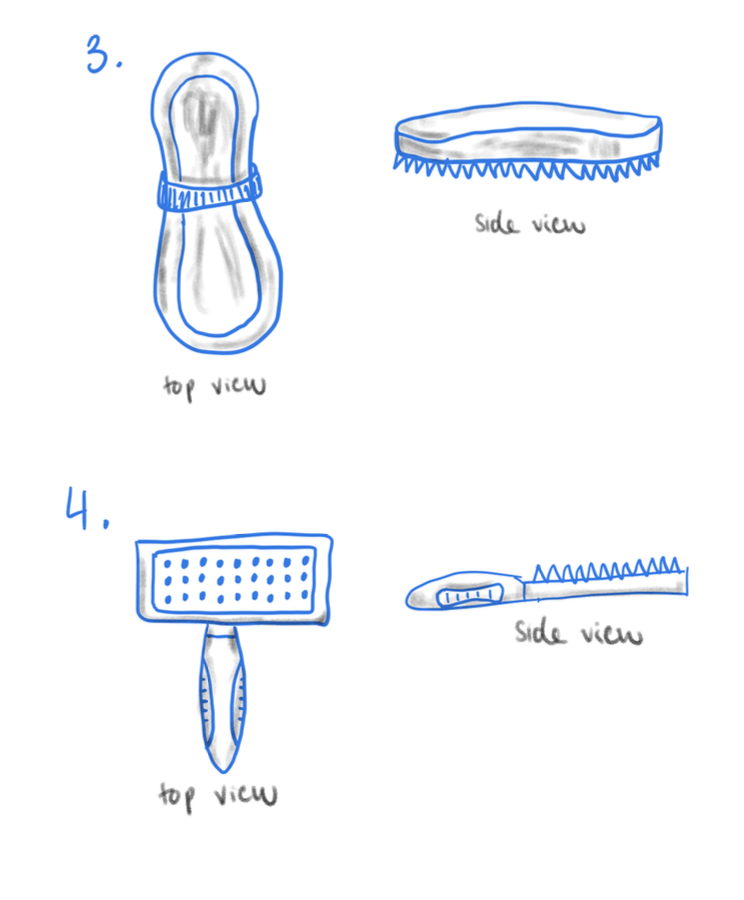
ergonomic curry comb
TIMELINE: February 2024
PROJECT TYPE: Class project
SKILLS: Foam cutting, CAD, sketching, user interviews
Project brief:
Consider the physical human factors and ergonomics of a hand tool, such as woodworking or kitchen tool, and re-design its form to improve its ergonomics through iterative design and qualitative testing with users.
IDEA:
I chose to re-design a curry comb, a tool I use almost daily as a member and Horse manager of the Stanford Polo team. Curry combs are used in the first step of brushing a horse, to loosen all the dirt before you brush it away with a brush. The curry comb is used with lots of force in circular motions all over the horse’s body to scrub at/loosen the dirt
Step 1: analyze the problem
First, I identified problems with the current curry comb design:
Circular movement combined with excessive downward force exerted continuously creates wrist and shoulder fatigue.
Difficult shape to grip with hand: slightly too wide and not thick enough to wrap fingers around it. Grip relies heavily on strap, which is often mis-fitting, is not adjustable, and is thin/prone to snapping.
Strap creates pressure on the back of hand; force shifts with circular movement, causing rubbing and pain points.
Unnatural wrist angle as you brush certain parts of the horse (all different angles required to cover the whole body).
and created two biomechanics diagram sketches to label these problems.
Step 2: brainstorm & ideate
I worked with my teammates to refine the biomechanics diagram (on the right) and concretely define our design requirements:
Size and shape that can be held comfortably in average hand.
Ergonomically shaped to be easily gripped by hand without excessive gripping force
Grip is designed to accommodate both right and left-handed individuals
Handle is angled in a way that reduces awkward wrist angle when held against a horse/flat surface.
Angle adjusts to accommodate shift in surface angles as brush moves across different parts of horses body – avoids twisting hand and wrist motion
Adequate clearance around the handle to avoid fingers coming into contact with the horse or the tool’s bristles (keeps hand clean)
Handle strap adds support/stability to grip and fits all hand sizes.
Width and material avoids exerting painful pressure on back of hand
Then I ideated and sketched 10 concept solutions to address the observed needs and human factors constraints:
Step 4: user testing phase I
We had three users test each of our six foam model prototypes:
#7:
Each user filled out a RULA Evaluation Sheet to score each prototype based on posture and other biomechanical issues they observed:
Results/User Feedback:
Of our 6 designs, #3 was the most successful among our three users. We plan to develop this design further, specifically aiming to accommodate smaller hand sizes. One challenge we observed is that each user seemed to prefer different finger-hole shapes and placements/distances apart, so we will continue testing for grip comfort in our next iteration. In addition, while all three users seemed to favor design #3, they all mentioned that it lacked palm support - we will make sure to hone in on this design parameter as well in our next iteration.
#7:
Design #3:
Step 3: prototyping phase I
We selected 6 designs and created a rough foam model for each:
Step 5: prototyping phase II
Step 6: user testing phase II
For our second round of user testing, we designed a hand tool comfort survey for the curry comb.
We chose to test our curry comb on the following four design measures:
Grip comfort
Grip comfort is important because it dictates how the tool feels before the task is even performed.
Grip stability
Grip stability is crucial because as the brush experiences significant friction brushing through course hair, it is necessary that the tool will not slip.
Finger placement
Finger placement is important because, as we test on different sizes of hands, we hope that a diverse range of people will be able to benefit from the redesign of this tool.
Wrist angle
Lastly, wrist angle matters to us because it is arguably the main design flaw in the original curry comb. With two bristled surfaces, we hope this issue will be reduced.
Descriptions of our 3 users + annotated images of each user testing each prototype:
USER 1:
Female, small hands, fully able/no restricted movement
Hand width (thumb to pinky): 6.1”
Hand length: 6.3”
USER 2:
Male, large hands, fully able/no restricted movement
Hand width (thumb to pinky): 7.4”
Hand length: 7.8”
The current curry comb design
Results/User Feedback:
I also created an anthropomorphic features table with relevant data and chosen percentile ranges:
Refined biomechanics diagram
as well as a Hand and Wrist Pain Self-Assessment Survey to indicate pressure points or other discomfort they feel while using the prototypes:
#9:
RULA Evaluation Results
Based on our user feedback, we chose two parameters to play with/vary in our next designs: palm surface depth and finger-grip shape/placement.
We sketched 15 different combinations of these two parameters —>
Then we selected 6 of these 15 designs to prototype with foam models.
I chose #7 and #9:
#9:
USER 3:
Female, medium-sized hands, fully able/no restricted movement
Hand width (thumb to pinky): 6.5”
Hand length: 6.9”
final cad prototype:
We designed a Hand Tool Comfort Survey to help users evaluate our curry comb prototypes
In conclusion, our users liked the back curve of Katie’s second (curved) model, but both her models were too small for the width of their hands and the finger grooves were spaced for small fingers (too narrow, but also too deep). Sosi’s big model was a hit - users loved the curves, but they wished it was slightly smaller and had more palm support/curve. They found Sosi’s small model too small and cramped for their fingers. Users enjoyed the left and right hand flexibility of Sejoon’s large model, but found it less comfortable to hold. They liked the size of Sejoon’s small model, but wished there was more palm support/curve at the back.
Overall, our user feedback has led us to the conclusion that our final models should have a wide, comfortable grip to allow more grip stability and require less squeeze force. The finger slots should be wide enough and properly distanced to fit larger fingers (smaller fingers can still grip them if they’re wider). Finally, we will add a steeper/larger curve at the back of our models to create more palm support and decrease the awkward gap/empty space between the palm and the model - and extend the base of the model so it fits the whole hand, down to the base of the palm. This will maximize ergonomic comfort and grip support, and support a wider range of user anthropometrics (increasing accessibility)









































